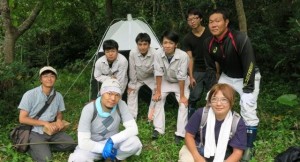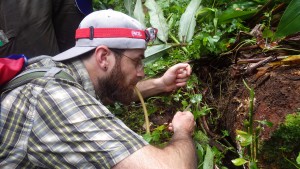
The OKEON project continues to progress and gain momentum, with the completion of site setup (72 traps on 24 sites) and being featured by various media outlets. On April 11, the Okinawa Times introduced the OKEON project as an environment monitoring network with an emphasis on insect collecting, and quoted Dr.Masashi Yoshimura, the staff scientist at Arilab and the coordinator of the OKEON project, who said that the project may collect up to six million individual specimens a year. It also promoted the importance of environmental education. The original article can be found here
Category: Collecting ants
OKEON project set up all 24 sites!

On March 31, 2016, the OKEON team set up the final site for insect collection in Higashi Village, located on the northeastern part of Okinawa. There are now 24 sites with a total of 72 traps (3 traps per site) across Okinawa.
Dr. Masashi Yoshimura, a staff scientist at our lab and the coordinator of the OKEON project, was interviewed by NHK to document the completion of site setup.
Takamine Ant Collection Donated to OIST
Mr. Hidetsune Takamine is a well-known Okinawan ant expert who has been collecting ants in Okinawa for around 40 years. His collection includes 116 species, 30 of which are endemic to Okinawa.
On November 26, 2015, Mr. Takamine donated his ant collection to OIST at a handover ceremony that took place at the Biodiversity and Biocomplexity Unit and will be stored in the unit’s specimen shelf as the Takamine Collection.
Dr. Masashi Yoshimura and Prof. Evan Economo expressed their gratitude towards Mr. Takamine, emphasizing how much this donation would contribute to academic research and more specifically how it would improve the scientific research on Okinawan biodiversity and help us understand how the diversity of Okinawa fits into the broader picture.
Samoa Collecting Trip
In April, 2015, Eli and Cong made a two-week collecting trip to Samoa. One purpose was to look for two endemic species Pheidole aana and Pheidole atua, which was last collected in 1967 before this trip. They ended up finding Pheidole aana, along with four other endemic species among the 33 ant species collected during this trip. They also recorded two new genera from Samoa, Discothyrea and Proceratium. Moreover, they collected native forest species at an altitude as high as 1400 meters.


Bannapone!
Benoit, Cong, and Benjamin made a great discovery on their trip to China, the first workers of one of the rarest ant genera in the world, Bannapone! The genus had previously only been known from a queen collected about 15 years ago. Our paper describes the worker of a different species of the genus.
See the paper here: http://biotaxa.org/Zootaxa/article/view/zootaxa.3734.3.6
and news article here:

